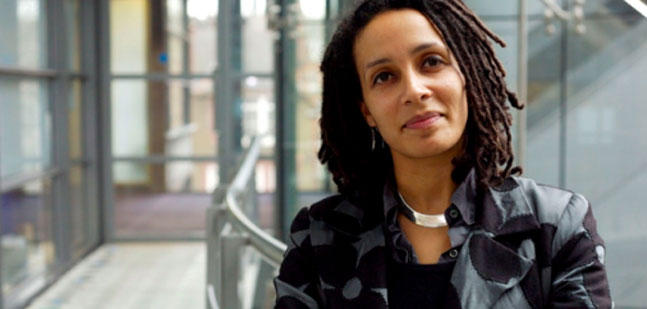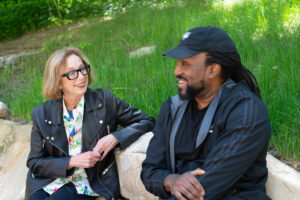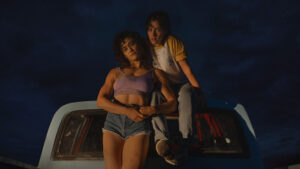[Editor’s Note: One of our favorite things about celebrating 20 years of Sundance Institute’s Documentary Film Program is reflecting on the powerful leaders that the program has had at the helm. Today, we’ve pulled an insightful piece written by former director Tabitha Jackson from 2014.
Her thoughts on the state of documentary are as important as they were nearly a decade ago and her reflections on the DFP are a great look into our historic past.]
by Tabitha Jackson
Tabitha Jackson is approaching her first anniversary as director of the Documentary Film Program at Sundance Institute. This week she spoke at DOC NYC to shares some thoughts on the cultural value of documentary film, the contemporary documentary landscape, and shared a personal promise as well as a call-to-action for the year to come.
Thanks to Thom and Raphaela for having me. I’m in grateful awe of the community they have created and supported around documentary filmmaking. In December, I will have spent a year as director of the Documentary Film Program at Sundance Institute. In that time I have travelled around the world, meeting our filmmakers and funders, our friends and our future collaborators. Which is why I look like I currently look. The shell of a woman.
This morning, I want to reflect on what has stayed with me.
10 things I value about documentary film:
- When documentary film is metaphor not simile.
- When documentary film is the painting not the photograph.
- When documentary film is slow food not fast food.
- When documentary film is honest but it is A truth not THE truth.
- When documentary film is empathy not sympathy.
- When documentary film is the question not the answer.
- When documentary film is the transformation not the transaction.
- When documentary film is ambiguity and complexity not certainty and simplicity.
- When documentary film is meaning not explanation.
- When documentary film is art as well as craft.
That’s just what I believe. What does the Sundance DFP believe? During our first team away day we came up with this sentence to encapsulate why we do what we do:
Art changes the way we reach people.
And so our three values:
art – excellence in form.
reach – finding the audience and the new storytellers that will keep this art form relevant and vibrant.
change – empathetic and social
The DFP was built on the twin pillars of human rights under Diane Weyermann (with the support of the Open Society Foundations), and social justice under Cara Mertes (with the support of Ford Foundation). These are still non-negotiable aspects of the work that we do, but so too is art, and that is what I’ll be focusing on today.
A word on reach: We care about movies being seen. What use is a story without someone to hear it? Similarly, a film isn’t finished until an audience has received it. So we are looking at new ways to take advantage of today’s technology (through #ArtistServices) to help artists connect directly with their audiences and take a share of entrepreneurial control.
But there’s another kind of reach. We also need to reach the filmmakers who can tell the story of our times, and they can’t all afford to spend two years fundraising and another three to make their film. If we’re not careful, documentary filmmaking will be the preserve of the elite. Lack of sustainability leads to lack of diversity, which in my opinion leads to a de facto censorship and an erosion of documentary’s cultural value. This, despite us being in a golden age, presents us as a community with one of our most pressing challenges.
A word on change: We live in exciting times as philanthropists, corporations, and brands have come to fully recognize what filmmakers and foundations have always known – the power of documentary to effect social change. Many of our filmmakers make films to change the world, and we support them in that, but Sundance is not a campaigning organization. Rather, its animating purpose is to support artists to find their voice and be true to their creativity. People will only be moved to act if first they are moved, and that is where the art comes in.
The Art
First off, in this noisy distracted world, let’s just sit and listen to something. This is the great writer and thinker Wendell Berry being interviewed by one of our grantees, filmmaker Laura Dunn.
I like to think that we, like Wendell, are dandelion people too, and that we see what fits together and try to fit it together. In other words, we are trying to make sense of the world.
Now I want you to watch something:
That was from a short film by the Latvian director Herz Frank, whom I had the privilege to meet not long before he died. 10 minutes long, one shot, every emotion.
Frank once said, “The first rule of a documentary filmmaker is: Have the patience to observe life! If you are observant, if you look not only with your eyes, but also with your heart, then life, for sure, will present you with some particular discovery. Then, the reality recorded by you will gain artistic value, become in line with art, and will always excite people. The facts and events will become old. They become history. [But] the feelings we felt regarding those events stay with us. Therefore, art is the only living bridge between people of various generations, between time periods.”
This is a compelling explanation of why great arts sustains. For me, film is one era talking to another era. What do we want to say? What do we want to show them? The job of the artist is to notice things. In fact the meaning of the word aesthetic is not ‘lovely loveliness’ but rather comes from the ancient Greek work meaning ‘to perceive’. So, documentary is an aesthetic medium in the true sense of the word. Giving ourselves the time and space to perceive things will determine what we say.
But it’s not just what we want to say, but how we say it. And what makes art is the how of how it is said.
This is one of my favorite paintings. “The Monk by the Sea” by the German Romanticist Caspar David Friedrich. No one does spiritual contemplation like him. I love it because he painted it. No one else could have done it and that’s what I mean by a distinctive artistic voice. In the words of Ernst Gombrich in his seminal The Story of Art, “There is really no such thing as art, only artists.”
This painting is also one of my favorites, but for a different reason. In 1994 artists Vitaly Komar and Alexander Melamid hired an opinion research firm to conduct a ‘scientific sampling’ of 1,001 adults. After sifting through this statistical portrait of the nation’s aesthetic biases, Komar and Melamid created “The People’s Choice,” the exhibition of paintings that objectively reflect American tastes.
The artists’ goal, according to a press release, is to replace “the archaic ‘hit or miss’ system of artistic creation…with a truly scientific mechanism assuring that the popular taste will be served!” (Ralph Rugoff, FRIEZE)
They were of course making a point – taking the artist out of the equation, making the creative process invisible, and focusing only a desired outcome. And this leads us to one of the frustrations articulated by our friend and Creative Advisor Joe Bini, which I happen to share. As he said in his keynote at the recent IDA conference:
“…[often] the creative approach to the filmmaking is ass-backwards. By focusing on the end game you are putting the cart of reaction and effect before the horse of creative expression. The horse of creative expression is a friendly horse. She doesn’t bite. Much. Free expression should not always have a preconceived result in mind, it should be free.”
So what should we take from all this if we are to preserve the cultural value of documentary?
Firstly, we need to create conditions in which our artists can notice things. And those conditions don’t just happen. They take space, time, and probably money.
Secondly, we need to value and support the distinctive voice of the artist with no certainty of the outcome of their endeavors. The journey is as important as the destination.
Thirdly, the lingua franca of non-fiction filmmaking should be the language of cinema and not the language of grant applications.
And this is where Sundance comes into its own…
The Role of Sundance Institute
In 1981 Robert Redford created a space in which artists could come together free from the political and commercial constraints of the industry. Imbued with the principles of generosity, creativity, and community, they could explore their craft and find their voice.
My colleague Michelle Satter founded the first Sundance Institute Directors Lab and over 30 years later she is still doing it.
The Labs have nurtured the voices of storytellers like Quentin Tarantino, seen here at the 1991 Directors Lab work-shopping Reservoir Dogs. The DFP is of course younger but has still seen some remarkable talent come through the Lab doors. Perhaps Laura Poitras is our documentary equivalent of Tarantino.
This is at the heart of our work. It was needed in 1981, and it is needed now more than ever.
THE CHALLENGE
The origins of cinema are firmly rooted in documentary, and it feels like we’re reinventing it all over again. But it’s not all good news. Consider this thought from a positive piece in the National Post about Sundance Grantee Jesse Moss’ The Overnighters:
“Novices are … left to struggle in a competitive market, which, combined with a dearth of critical early-stage funding, prevents documentarians from raising the funds to experiment within the field, especially with long-term projects. Time is not on their side, and it’s hurting a medium that could stand to deviate occasionally from fast-turnaround, agenda-pounding fare.”
Georges Melies was also in the audience in 1895 when the Lumiere Brothers showed that train pulling into the station. He took the form in a completely different, magical imaginative direction. If he were trying to raise funds today would he feel he had to articulate an outreach campaign about rocket-related eye injuries?
That was a cheap shot, but I do want to throw down a challenge to funders, filmmakers, and audiences.
FUNDER CHALLENGE
We must support and promote the intrinsic value of documentary as much as its instrumental value. The two are not in opposition, as Cara Mertes so eloquently pointed out in her recent IDA Keynote about false dichotomies.
So let’s ask not only what documentary can do for us, but what we can do for documentary.
Actually, we could do worse than listen to the Ford Foundation again for an enlightened approach to getting the balance right:
W. McNeill Lowry, the first great funder of the nation’s not-for-profit arts from his perch at Ford, wrote,“At its most basic level, art is […] about the surge of artistic drive and moral determination.[…] And philanthropy, in the arts at least, is professionally motivated only when it accepts the artist and the arts on their own terms, and learns from the artist himself at least to recognize the atmosphere in which the artistic process is carried out.” (From Todd London on Innovation)
FILMMAKER CHALLENGE
- Find the creative space to notice things
- Use your artistic voice to express those things
- Define your own measures of success
- Be bold
In the words of the great filmmaker Victor Kossakovsky, “Don’t film if you want to say something – just say it or write it. Film only if you want to show something, or you want people to see something.”
AUDIENCE CHALLENGE
We’ve never had more access to film, let’s make the most of it.
- Demand more from documentaries
- Discover more, both new voices and old masters
- Experience more
- And maybe even go the cinema now and again…
Sundance Challenge
So it’s all very well challenging everybody else – what are we going to do? Well, next year will be a year of experimentation.
With our fund. We will continue to broaden the range of what we fund and look at the mechanism of how we fund it. We will make sure that we are a funder active in the development space. And, we will see if we can grant in a way that’s more responsive to the needs of the filmmaking process.
With our artists. Our standard across the board is artistry, no matter what the subject of the film. We are in the process of creating a new initiative to identify, nurture, and support a cohort of voices we feel are truly distinctive. This will happen slowly at first to allow the artists to ahve the freedom to investigate and to fail. The weight of expecatation can often be a constraining and oppressive thing.
Finally, no good talk about documentary would be complete without a call to action.
I’m still new to this game, but If I presumptuously imagine Sundance to be at the center of the indie doc landscape, when I extend my hand in one direction towards the issue-driven film community – for support, for money, for infrastructure – it is grasped warmly and firmly and by many. But when I extend my hand in the other direction towards the other kinds of films, I struggle slightly. Where is the infrastructure, where is the support, where is the financing? I see Creative Capital, and I see Cinereach, and of course there are others. But it seems to be less populated, less funded, less valued even? My dream is that If we all come together — financially, communally, experimentally – then we can trust the artists to lead us creatively, morally, and socially. If we let them…




